Study of Carrefour’s seafood sales reveals benefits of traceability tracking

A new study from of Carrefour’s sales of Northeast Atlantic cod hints that traceability – and by association, fisheries sustainability – pays off.
Retailers stand to increase profitability by increasing the sustainability of their seafood supply chains, according to a study sponsored by French bank BNP Paribas and published in June 2022 by financial think tank.
Based on a detailed study of seafood sold by the Carrefour chain, “How retailers can be sustainable and profitable in seafood” suggests profit yields in the store were lowest for the most-overfished species.
The study singled out cod from the Northeast Atlantic, waters which are frequently the focus of European Union regulations on overfishing, as an example of a product delivering low margins to Carrefour. At the same time, items like French shellfish, with a higher degree of traceability, recovered a higher profit margin for the retailer.
“Increased seafood supply chain disclosure, rather than being a cost, could lead to a significant increase in profit [for supermarkets],” the report’s author, Francois Mosnier, who is also the head of Planet Tracker’s oceans program, wrote.
Planet Tracker estimated 7 to 16 percent of Carrefour’s seafood sales in its French outlets are fish deemed to be coming from overfished stocks. The retailer could reduce that total while improving its profit margins by issuing a time-bound target aimed at sourcing a significant share of its seafood volumes from fully traceable sources, Mosnier said.
“Disclosing details of its seafood supply chain (e.g. on the Ocean Disclosure Project) would generate net financial benefits for Carrefour equal to 3 percent of its estimated gross profit on seafood in France. Supporting initiatives on seafood traceability (e.g. Global Dialogue on Seafood Traceability) could also be monetized,” Mosnier wrote. “Centralising sustainability data on Carrefour’s seafood supply chain, analyzing it, and disclosing it publicly would provide benefits that exceed the costs incurred. Indeed, we have estimated the financial benefits arising from bringing in more disclosure – by computing the time and efforts needed to add this extra information and then the financial benefits linked to better centralized management. Overall, over five years, the net benefits of greater seafood supply chain disclosure are worth about 3 percent of the estimated gross profit made on seafood in France for Carrefour France under our conservative assumption … Benefits exceed costs from year one, and the vast majority of the benefits would materialize in year one.”
Moreover, investing in robust traceability solutions is likely to generate attractive returns for seafood processors, Mosnier wrote.
“Carrefour could therefore provide financial incentives for processors that have not yet done so to invest in traceability, where the funds provided by the retailer could be invested by the processor into a traceability solution interoperable across the supply chain (by using the GDST standards),” he wrote. “The financial benefits of this investment (on average, we estimated that the EBIT margin of a seafood processor could double by investing in traceability) could then be shared with Carrefour.”
While such arguments may hold sway in Western markets, efforts to encourage traceability uptake in Asia’s retail sector remains “very challenging” with “very little oversight” by regulators, according to Yvonne Sadovy de Mitcheson, a professor at the Swire Institute of Marine Science at the University of Hong Kong.
“Government really needs to mandate labeling on seafood species and provenance and whether it’s wild or farmed, as is done in so many other countries,” she told SeafoodSource. “Also, it could encourage companies that import sustainably produced and certified products and require companies to provide more information on origins including use of chemicals.”
Sadovy said she sees Hong Kong’s problem as “a chicken-and-egg situation.”
“Not enough consumers are asking for or aware of sustainable seafood issues and companies are not rewarded for the extra trouble they would likely have to go through to seek such sources. So we are in a difficult phase of the attempt to shift to sustainability,” she said.
Possibly the best way to grab the Hong Kong public’s attention about sustainability is through emphasizing the public health risks of possibly contaminated and untraceable seafood, Sadovy said. That effort is already being undertaken by the Marine Stewardship Council, which in 2021 launched a new strategy for uptake of its certification in China, stressing the utility its eco-label as a guarantor of food safety and quality, with less emphasis on ocean or fishery sustainability.
Photo courtesy of bogdan Ionescu/Shutterstock






Share